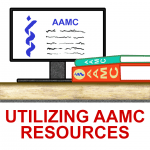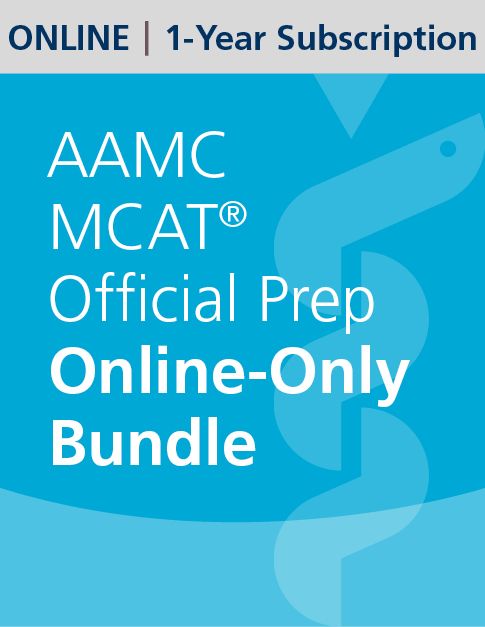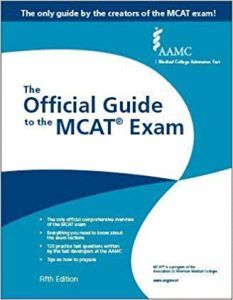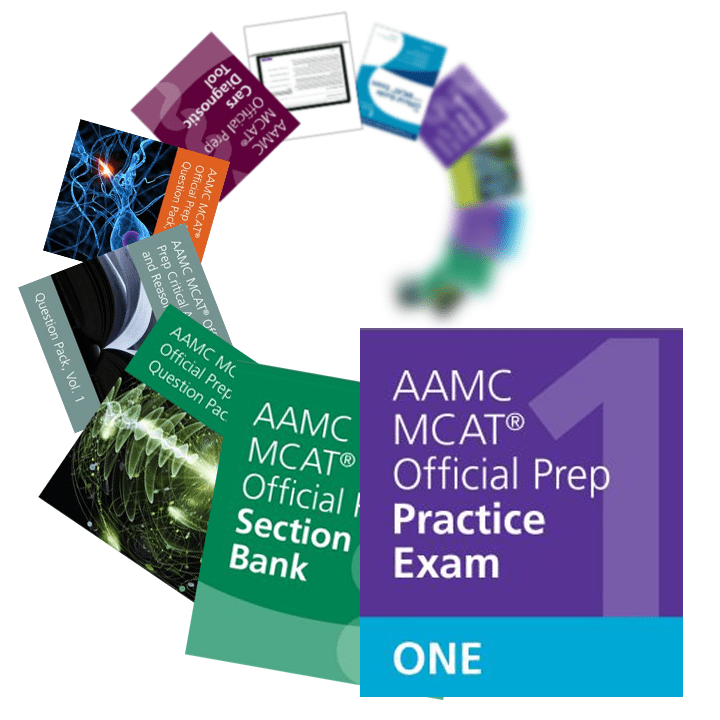 When it comes to MCAT prep, there are many resources available. Too many resources, in fact.
When it comes to MCAT prep, there are many resources available. Too many resources, in fact.
There’s the recommended AAMC materials and many third party ones as well.
Today, I want to discuss the AAMC resources specifically,
including what they are,
why you should use them,
when to use them,
and when to ABSOLUTELY AVOID THEM or else…
For more on 3rd party resources, see my MCAT Resources Page.
What AAMC Resources Are Currently Available?
As I’m typing this, here is what’s currently available from the AAMC.
Note: You can purchase the AAMC MCAT Official Prep Bundle (AAMC) to get one year of online access to ALL of the practice materials described below.
Full Length Practice Tests

The AAMC has released a total of 6 full length exams.
The first is the ‘Free Sample Test', which, while following the complete style and format of a full length, does not provide a final score within the 472 – 528 range.
Instead, your scores on that test will be presented to you as a fraction of correct answers per total for each section.
You can use an online calculator to estimate (they’re usually slightly off) your ‘real’ scores and see where you stand.
My students tell me that this exam feels slightly shorter and easier than the other full lengths. This is why I recommend it as a potential baseline exam or as the final exam to take before your real MCAT. All of this explained below.
5 Official Scored Practice Exams
(4 are available for purchase and 1 free scored exam)
These exams feature questions taken from actual previous exams, with proper scoring in the range of 472 – 528, just like the real MCAT. I recommend taking these near and during phase 3, as explained below.
AAMC Official Guide To The MCAT – Practice Questions

The Official Guide (Amazon) is a detailed book, which explains the MCAT.
The guide includes an overview of the exam itself, tips on everything from payment to registration, and details on test day procedures, scores and more.
All of this information is more readily, and in my opinion more CLEARLY, available online. Especially if you watch my YouTube videos.
However, the guide also includes a set of practice questions which are key. These are available (without the guide itself) in the online AAMC bundle.
AAMC Official Question Pack
The question packs feature practice questions from some of the older MCAT material, meaning from the older style (pre-2015 shorter) MCAT. They include questions from Biology, Chemistry, Physics and CARS.
AAMC Official Section Bank
The section bank includes 300 discrete and passage-based practice questions and DOES cover the newer additions to the MCAT. These questions are NOT taken from the pre-2015 MCAT. The section bank includes questions for the Chem/Phys, Bio/Biochem and Psych/Soc sections.
AAMC CARS Diagnostic Tool
This tool is meant to help you prepare for the CARS section of the MCAT. It includes 28 passages with videos that walk you through a handful of the passages.
AAMC Official Independent Question Bank
The question bank (formerly called Online Flashcards) features 150 discrete questions from the different sciences as yet another tool to practice and review.
Now that we’ve covered what’s available from the AAMC,
how do you best utilize these resources so that you’re not overwhelmed by them and so that you don’t burn through all of them too quickly before your test date?
Let me reiterate again.
The absolute BEST practice materials to prepare for the MCAT are the questions and passages offered BY the AAMC.
Think about it. Third party companies study the MCAT in the hopes of replicating their exams to provide you with good practice material.
But they don’t have access to the source. They aim to do their best, and some get pretty close.
But in my experience, no third party company is as good as the AAMC.
Which is exactly WHY I want you to HOLD OFF on using the AAMC practice materials.
What??
Ok, let’s back up.
I advise against starting with AAMC resources for 2 main reasons:
- When you’re just starting out and getting your feet wet, you’re not ready to truly appreciate what the AAMC materials have to offer.
- Despite the apparent overwhelming amount of resources, they will eventually run out. You want to time your practice to finish going through your resources just before test day.
They say that the best way to prepare for the MCAT is to practice.
And so the dedicated student might jump right into practice passages and bomb miserably.
Not because they’re stupid,
Not because they’re not cut out to be a doctor,
Not because of anything other than the fact that they simply jumped in before they were ready.
Why torture yourself with feelings of overwhelm, burnout and incompetency?
Why start with a goal that is only setting you up to fail?
This is why I not only advise against starting with AAMC resources but also advise my students to hold off on practice passages completely (other than CARS) in Phase 1.
More on the 3 phases of MCAT prep here: How Much Time Do You REALLY Need?.
Once you’ve completed Phase 1 and have that solid content foundation,
You’re ready to begin practicing.
Those first few weeks of practice passages may feel miserable.
Yes, you’ve studied content.
But do you remember it?
Or worse, do you remember studying it but cannot recall the exact name, formula, equation…?
This is perfectly normal.
Confidence and skill will come with practice.
This means that the first few practice passages are all about getting your feet wet, learning the ropes, burning through passages for the sake of doing passages and getting the hang of it more than anything else.
Assuming you’ll be taking the MCAT at age 21 or older, let’s use alcohol as an example.
When you first start drinking,
alcohol is just alcohol.
At 21 (cough cough) you probably couldn’t tell the difference between a $0.50 can of cheap beer or a $10 pour from an exotic microbrewery.
In fact, the $10 beer would have been wasted on you.
And what college student can afford that anyways?

But perhaps as you got older, as you understood the tastes a bit more, you became aware of the differences. Perhaps now you can tell the difference between the cheap mass-brewed and watered-down variety and the exotic microbrew.
If alcohol is not your thing, think about how your taste buds have evolved to differentiate coffee, chocolate, or ice cream. Or let’s step out of the gustatory (taste related) realm and think of something else.
 When I first started running, any cheap shoe, legging, or sports bra worked for me. As I discovered my style, I became very particular about fit and comfort. My ‘tastes’ evolved as I became more sophisticated in my exercise (and more clever like this top for my first pregnant 5k) .
When I first started running, any cheap shoe, legging, or sports bra worked for me. As I discovered my style, I became very particular about fit and comfort. My ‘tastes’ evolved as I became more sophisticated in my exercise (and more clever like this top for my first pregnant 5k) .
Alcohol and running gear?
The idea is that, when you first get started with something, you don’t really care about the quality. And so the ‘expensive’ stuff, in this case the limited yet valuable AAMC resources, is wasted on you.
But as you become familiar with the test, as your ‘taste’ develops, as you work out the kinks like basic content, timing strategy and more, NOW you’re ready to truly appreciate the value that comes from the AAMC material.
Which brings me to my second point:
Since there are not enough AAMC resources to carry you through the entire MCAT prep process, let’s try to save them until the very end.
Any time you work closely with a third party company,
In addition to learning from your mistakes as you practice,
You also learn the nuances of the company.
I’ve had students excel at Blueprint (formerly Next Step) or Altius exams simply because they were able to dissect the exams so well that they learned that company’s specific test-taking patterns and strategy.
This would be a great skill to master if those same tricks would carry over to the real thing!
But the real MCAT is written by the AAMC and, therefore, will be slightly different in style from the third party company exams.
And so, if the AAMC is writing your actual exam, don’t you want the materials you use to prepare (and thus the patterns you learn) to be reflective of that exam style?
This is why I recommend burning through the third party resources first.
And then, as you get closer to taking your MCAT, find that point in time where you will be able to work through the AAMC materials (ideally twice) without running out of questions and being forced to go BACK to third party resources.
By finishing your MCAT prep with the AAMC materials, you will not only refine your overall testing strategy. (Remember, you’ve already worked out the major issues and kinks with 3rd party resources.)
You will also be able to focus on studying the AAMC testing style.
How do they want me to think?
How do they like to ask questions?
How do they like to trick me with the answer choices?
Is there a pattern in how they present facts, data, numbers…?
How often do they expect me to go back to the passage?
And so much more.
These are just some of the patterns that I work through with my tutoring clients as we’re reviewing AAMC materials.
But if you start with the AAMC materials when you’re still struggling with the basics like content, equations, reading comprehension or timing, you will be too distracted to focus on the patterns above.
When To Utilize the AAMC Material
Knowing all of this, how do you plan to utilize these limited resources?
Here is the plan I follow with my Study Hall members.

Baseline Exam:
This can be the AAMC Unscored Sample test. You won’t review it.
Instead, you simply use this exam to get your feet wet and get an idea of what’s to come.
I only recommend the AAMC as your baseline IF your MCAT is over 3 months away.
You can also use any 3rd party company exam for this.
Early to Mid Phase 2:
Begin your Phase 2 practice with a third party company. Then, when you’re about 2 months out and ideally scoring within 10 points of your target, switch over to AAMC practice material. This includes the flashcards, CARS diagnostic tool, section bank and question pack.
Late Phase 2:
Since there are 6 AAMC exams in total, I recommend planning it so that you’re taking 4 weekly AAMC exams in Phase 3. This leaves you 1 more exam to take at the end of Phase 2.
The ideal spacing would be:
- AAMC #1: 6 weeks out
- AAMC #2: 4 weeks out
- AAMC #3: 3 weeks out
- AAMC #4: 2 weeks out
- Unscored Sample Test: 1 week out
Why this order?
Having been banned from taking the MCAT myself, I speak to students after every exam to understand their experience. One question I always ask is how they would rank the official exams in terms of difficulty and closeness to the real thing.
The consensus is as follows:
- The sample test is slightly shorter and easier than the real thing. I personally have also noticed that the online score estimation calculators tend to overinflate scores. Why not build your confidence by ending your prep on this easier exam?
- Exam 1 is also an easier exam. This is a good ‘warmup’ exam and a good gauge of “Am I really ready to enter Phase 3?”
- Exam 2, while not as close in style to the real thing, tends to have the closest SCORE to the real thing. While the others may be slightly inflated, this one gives you a very good idea of how you may score on test day.
- Exam 3 is close in style to the real thing, but the scores (as of 2021) are slightly inflated. It is not unusual to see a 3 point jump compared to your previous scores and then a 3 point drop on the real thing.
- Exam 4 is harder and closer in style to the real thing. I have seen mixed results in terms of where the scores place, but I suspect (not enough data yet) that it’s also slightly inflated.
I will update my insights on Exam 4 after I collect more data since this came out before the pandemic and was immediately followed by the shortened pandemic exam. And who knows what the AAMC will do/change in the next year or so?
Before you run off to complete your MCAT study calendar, mapping out when you’ll take these exams, I beg you to keep one thing in mind.
These resources are LIMITED! Even though you’re allowed to take the same practice test multiple times, I only count the first time as valid.
In fact, I know some tutors have their students use nothing BUT the AAMC practice tests, having them take the same exam over and over.
But if a student scores a 495 and then repeats the exam over and over until they score a 512, I don’t consider that 512 valid.
How much of that score is due to actual improvement?
And how much is due to having learned the nuances and patterns of the questions in this particular practice exam?
And so, unless you’re 100% sure you’re ready, DO NOT start using these AAMC resources.
How do you know if you’re ready?
Take the emotion out of it and evaluate logically using ONLY data.
Use this to guide you: Am I Ready For the MCAT? How to Evaluate
Or, this is something we can figure out together in a Speed Coaching Call or by working with me in the MCAT Study Hall.
I want to hear from you.
What is the cringiest advice you’ve heard when it comes to preparing for the MCAT and, more specifically, using the AAMC resources?
Let me know in the comments below.


